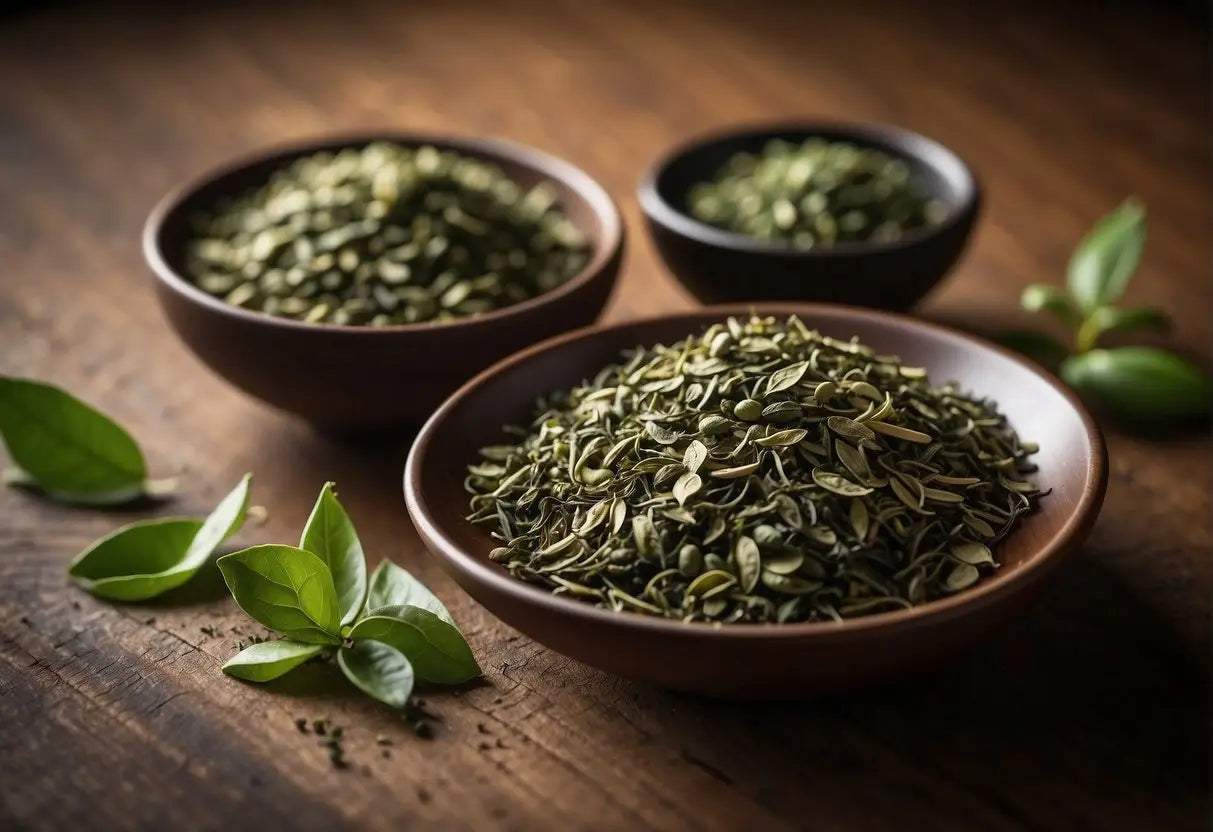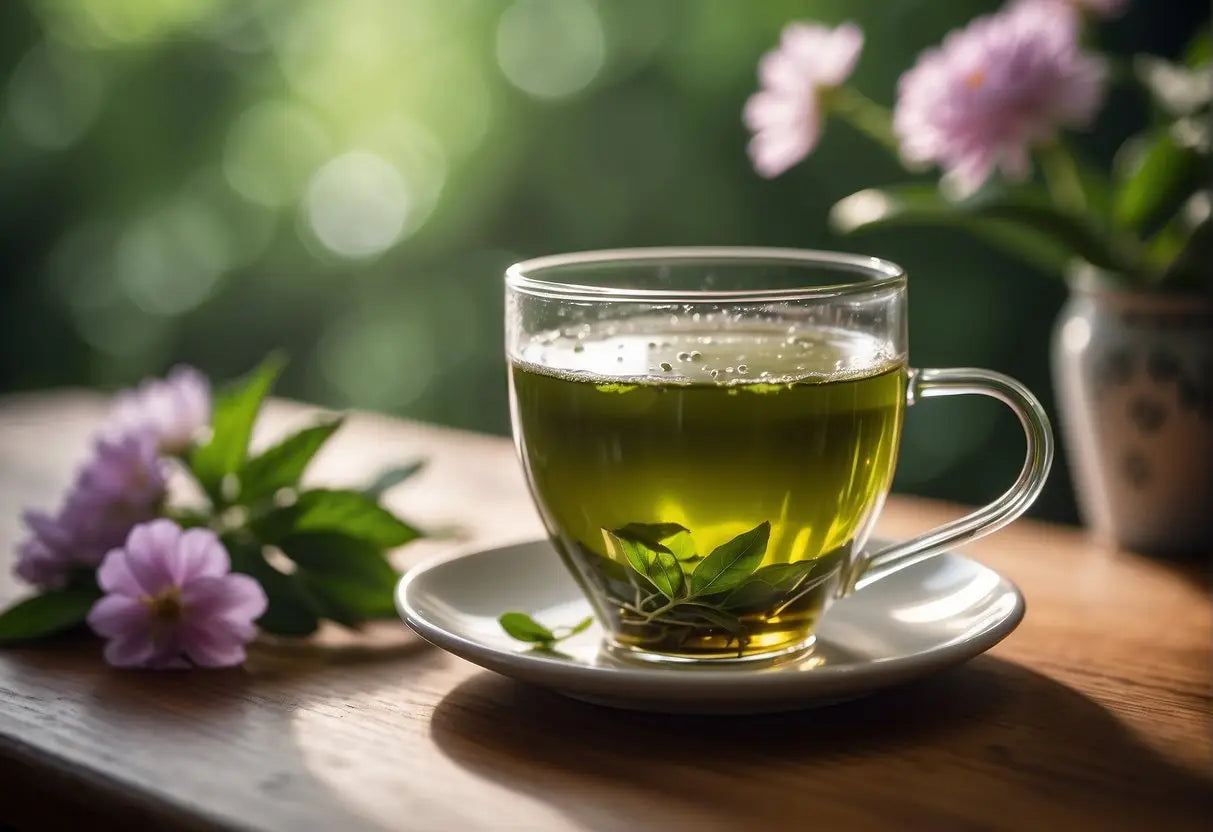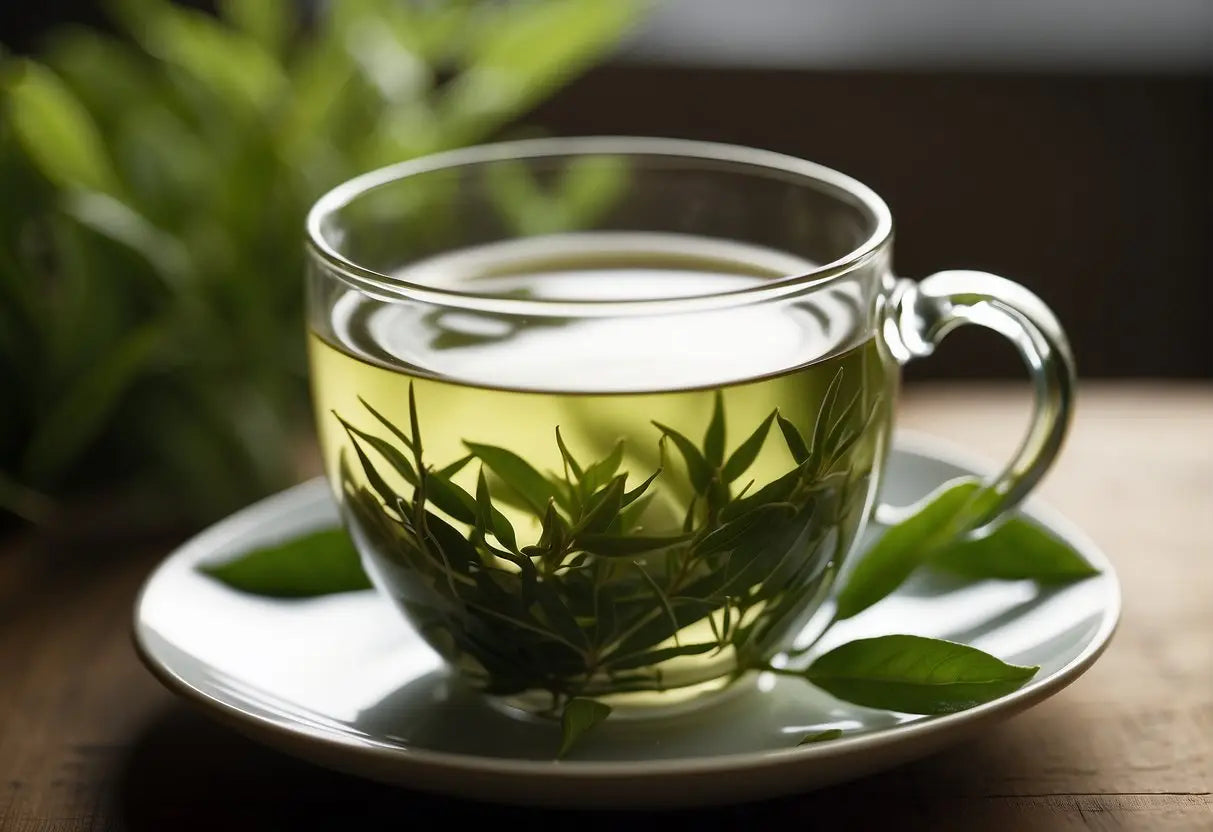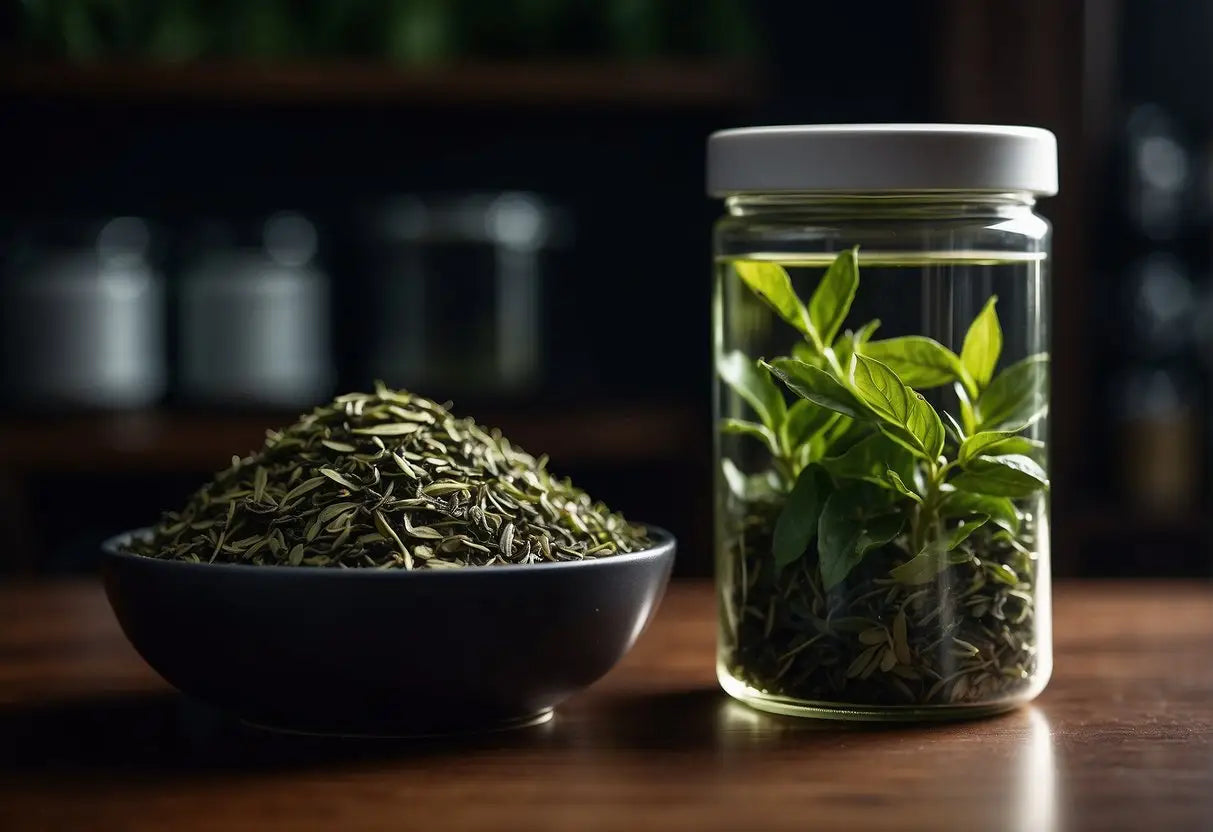What Does Green Tea Taste Like?
Shop our Pu Erh Tea collections!
Your experience with green tea can vary widely depending on the specific type of green tea, where it’s grown, and how it’s processed. Generally, green teas have a delicate flavor spectrum ranging from grassy to floral notes.
Key Characteristics of Green Tea:
Bestsellers
- Grassy: Most green teas have a fresh, grassy taste.
- Sweetness: Some varieties offer a subtle sweet aftertaste.
- Bitterness: A slight bitterness can be present, which is often a result of the presence of catechins.
- Astringency: A dry, sharp sensation can occur, especially if the tea is brewed too long.
- Umami: A savory quality that is more pronounced in Japanese green teas like Gyokuro.
Origin Impact:
- Chinese Green Teas: Typically pan-fired, these teas might convey toasted or smoky flavors.
- Japanese Green Teas: Usually steamed, offering a brighter, vegetal quality.
Proper Brewing to Optimize Flavor:
- Water Temperature: Keep it between 150°F (65°C) and 180°F (80°C).
- Steeping Time: Usually 1-3 minutes; longer infusions can increase bitterness.
| Flavor Aspect | Description | Note |
|---|---|---|
| Grassy | Fresh, reminiscent of freshly cut grass | Common in most green teas |
| Sweetness | Subtlety underlying; natural | Not overt or sugary |
| Bitterness | Mild to moderate; ties to health benefits | Avoid oversteeping |
| Astringency | Creates a ‘clean,’ dry mouthfeel | Not to be confused with bitterness |
| Umami | Rich, broth-like savory taste | Mostly in shaded Japanese teas |
Through your understanding of these flavor characteristics, you can better appreciate the subtle complexities that green tea has to offer. Remember, the quality of leaves and the brewing method are paramount to ensuring the best possible taste experience.
Discover our best-selling raw Pu Erh tea and elevate your tea experience today!
Types of Green Tea and Their Flavors

The flavors of green tea vary greatly depending on its type, region of growth, and processing methods. Here, you'll learn the distinct tastes characteristic to each variety of green tea listed below.
Sencha
Region: Japan
Flavor Profile: Fresh, grassy, with a slight oceanic note
Sencha is the most popular green tea in Japan. You'll experience a balance of sweet and astringent flavors, often accompanied by a refreshing vegetal quality reminiscent of steamed greens.
Matcha
Region: Japan
Flavor Profile: Rich, creamy, with a hint of sweetness
Matcha is a powdered green tea used in traditional Japanese tea ceremonies. It presents a vibrant green color and a unique taste—think of a smooth and creamy texture with a slight vegetal sweetness and umami undertones.
Dragon Well
Region: China
Flavor Profile: Nutty, smooth, with a subtly sweet finish
Also known as Longjing, Dragon Well tea is pan-fired, creating a distinctive taste. It's characterized by its mellow, roasted aroma, a smooth mouthfeel, and a lingering, slightly sweet aftertaste.
Gyokuro
Region: Japan
Flavor Profile: Brothy, umami, with a deep green infusion
Gyokuro is a shaded green tea, creating a darker leaf and a richer flavor profile. You'll notice its broth-like quality, full-bodied texture, and deep umami flavor that's more pronounced than other green teas.
Biluochun
Region: China
Flavor Profile: Fragrant, fruity, with a gentle floral note
Biluochun is a spiral-shaped green tea known for its delicate aroma. When you sip on this tea, expect a light, refreshing taste with fruity and floral hints that gracefully dance on the palate.
Influences on Green Tea Taste

Lao Ban Zhang
The taste of green tea is shaped significantly by various factors from its cultivation to the final brewing process.
Cultivation Conditions
Soil Type and Quality: The quality of the soil where the tea plants are grown can greatly affect the flavor. High-quality, well-drained soil rich in minerals tends to produce tea leaves with a more nuanced taste profile.
- Climate: Tea plants favor a subtropical climate with ample rainfall. The amount and frequency of rain can influence the tea’s sweetness and astringency.
Processing Methods
Steaming vs. Pan-Firing: After harvesting, green tea leaves might be steamed or pan-fired, which are methods to halt oxidation.
- Steaming typically yields tea with vegetal and slightly sweet notes.
- Pan-firing often results in a toasty and nuttier flavor.
Rolling: Rolling the leaves breaks down their structure, impacting how the tea's flavors are released during brewing.
- Light Rolling: Maintains more of the leaf's original shape, generally leading to a milder taste.
- Heavy Rolling: Produces a more robust and concentrated flavor.
Brewing Techniques
Water Temperature:
- Hot Water (80-85°C): Enhances umami flavors and reduces bitterness.
- Boiling Water: Can increase bitterness and reduce the delicate floral notes.
Steeping Time:
- Short (1-2 minutes): Yields a lighter and more delicate flavor.
- Longer (3 minutes or more): Can extract deeper flavors but may introduce more bitterness.
Tasting Notes for Green Tea

In this section, you'll gain an insight into the multi-dimensional characteristics of green tea, focusing on its visual cues, aromatic profile, and the intricacy of its flavors.
Visual Appearance
When you brew green tea, expect to see a range of colors from pale yellow to vibrant green. The color is indicative of the tea's quality and type. A clearer, bright color typically suggests a higher-grade tea.
Aroma Characteristics
The aroma of green tea is often fresh and grassy, but it can also have undertones of floral, nutty, or seaweed-like scents based on its origin and processing methods. You should look for a clean scent with no hints of mustiness.
Flavor Complexity
The flavor of green tea can be quite nuanced depending on the specific variety and brew time:
- Sweetness: Some green teas have a delicate, sweet undertone resembling fresh grass or young vegetables.
- Bitterness: A slight bitterness may be present but should not be overpowering; it is often balanced by the tea's natural sweetness.
- Umami: High-quality varieties often exhibit a savory "umami" taste, adding to the depth of flavor.
- Astringency: This sensation, which can make your mouth feel dry, varies among different types of green tea.
Green tea offers a harmonious blend of tastes that can elevate your sensory experience.
Health Benefits and Green Tea Flavor

When you sip green tea, you typically experience a delicate flavor that is mildly grassy and often described as having a slight astringency. This natural bitterness is due to the presence of catechins, beneficial antioxidants that contribute to the health benefits of green tea.
Antioxidant Properties
Green tea is rich in polyphenols like catechins and flavonoids, which act as powerful antioxidants. These substances can reduce the formation of free radicals in your body, protecting cells and molecules from damage.
- Epigallocatechin Gallate (EGCG): A significant catechin in green tea, known for its potential to treat various diseases.
- Reduction of Inflammation: Antioxidants in green tea may help in reducing inflammation and thus supporting overall health.
Potential Health Benefits
- Cognitive Health: Regular consumption may improve brain function.
- Heart Health: It can potentially lower the risk of heart disease.
- Fat Burning: It's suggested that it can boost metabolic rate in the short term, aiding in weight management.
Routinely drinking green tea could complement a healthy diet. Its unique taste can be affected by numerous factors, such as origin, processing, and preparation. The flavor can range from sweet and floral to earthy and nutty, with variations in bitterness.
For a milder taste, you may steep your tea for a shorter time at a lower temperature, while a longer steeping period at a higher temperature may enhance the tea's inherent astringency. Your personal taste preference can guide you to the perfect cup that balances green tea's health benefits with its distinctive flavor profile.
Pairing Food with Green Tea

When selecting foods to pair with green tea, consider its subtle flavor profile. Green tea is a delicate beverage with grassy, floral, and sometimes astringent notes. Pairing it with food involves balancing these flavors without overpowering the tea.
Sweet Treats:
- Dark Chocolate – The slight bitterness complements green tea’s astringency.
- Fruit Tarts – Citrus or berry flavors work well with the floral hints in the tea.
Savory Snacks:
- Sushi – A classic pairing, the umami of the fish pairs nicely with the tea.
- Steamed Vegetables – Mild greens like bok choy or spinach enhance the fresh taste of the tea.
Baked Goods:
- Scones – Plain or with a hint of lemon, scones can absorb the tea’s flavors.
- Almond Cookies – Nuts add a richness that offsets the tea’s lightness.
Here’s a simple table to help you pair foods with your green tea:
| Food Category | Examples | Pairing Note |
|---|---|---|
| Sweet Treats | Dark chocolate, fruit tarts | Complement tea's astringency with sweetness |
| Savory Snacks | Sushi, steamed vegetables | Umami and mild flavors enhance tea |
| Baked Goods | Scones, almond cookies | Absorb and balance the lightness of tea |
Remember that green tea pairs best with foods that don't mask its delicate flavors. Your choice should complement and not compete with the tea’s natural taste.
Storing Green Tea to Maintain Flavor

When you store green tea properly, you ensure the preservation of its delicate flavor and freshness. The key factors in storing green tea are temperature, light, air, and moisture.
Temperature: Keep your green tea in a cool place, ideally below 25°C (77°F). Extreme temperature fluctuations can degrade the quality of the tea.
Light: Avoid storing green tea in direct sunlight. UV rays can initiate chemical reactions that compromise the taste. An opaque container is preferable to a clear one.
Moisture: Ensure the storage container is airtight. Any exposure to moisture can cause the leaves to deteriorate, becoming stale and flavorless.
Air: Limit the amount of air your green tea is exposed to. Oxygen can cause oxidation, which will adversely affect the taste. Re-seal bags or containers after every use.
Here are additional tips for best storage practices:
- Avoid Strong Odors: Store green tea away from spices or any strong-smelling foods that could taint its flavor.
- Separation: If you have different types of green tea, store them separately to prevent flavor cross-contamination.
- Original Packaging: If possible, keep the tea in its original packaging within an airtight container for an added layer of protection.
- Refrigeration: While not always necessary, some prefer to store green tea in the refrigerator to prolong its shelf life. If you choose this method, make sure the container is completely sealed to prevent condensation.
By adhering to these storage guidelines, your green tea will retain its quintessential flavor profile for your enjoyment.
Frequently Asked Questions
In this section, you'll find concise answers to common inquiries about green tea, including its taste profile, preparation tips, and comparison with black tea.
How would you describe the flavor profile of green tea?
Green tea typically has a delicate, slightly grassy or vegetal taste with a subtle sweetness and a gentle bitterness. The flavor can range from floral to nutty, depending on the variety and brewing method.
Can you make green tea taste better without compromising its health benefits?
Yes, you can enhance the flavor of green tea by adding natural ingredients like lemon, honey, or fresh mint leaves. These additions can improve the taste while maintaining the tea's health properties.
What influences the taste of green tea, and how does it differ from black tea?
The taste of green tea is influenced by factors such as origin, processing, and brewing time. Unlike black tea, which is fully oxidized, green tea is minimally oxidized, resulting in a lighter flavor and a more subtle complexity.
Is it common to add milk to green tea, and how does it affect the flavor?
Adding milk to green tea is not a common practice, as it can mask the delicate flavors and potentially alter the beneficial compounds within the tea. When milk is added, the result is usually a creamier texture with a muted tea flavor.
Why might some people find green tea to be bitter, and how can this be mitigated?
Green tea can become bitter if overbrewed or made with water that is too hot. To mitigate bitterness, steep your tea at a lower temperature, around 160-180°F (71-82°C), and for less time, typically 1-3 minutes.
What are some effective ways to enjoy green tea if you're not fond of its taste?
If you're not keen on the natural taste of green tea, try flavored green teas, such as those infused with jasmine or citrus. Cold-brewing green tea or blending it into smoothies can also make it more palatable.
← Older post Newer post →











